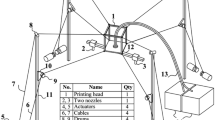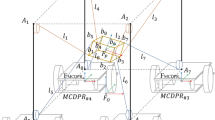Abstract
A novel cable-driven parallel robot (CDPR), featured with a simple structure and energy-efficient driving mechanism, for 3D printing building construction is proposed, and details of the design methodology are presented. To overcome the limitation of the previous approaches, the CDPR is designed to operate with only five cables; hence, its structure is simplified. To avoid the interference with the building being printed, lower cables are placed on a plane parallel to the ground and they are controlled to move synchronously up and down according to the height of the building being printed. Tension distribution of the cables required for the operation is analyzed using the constrained optimization problem. Workspace determination is presented in consideration of the cable strength as well using the tension distribution analysis. A gravity compensation mechanism is proposed and applied to reduce the energy consumption. The validity of the proposed CDPR and design methodology is verified through the simulation.
















Similar content being viewed by others
Data and material availability
For reasonable request, the datasets of the current study are available from the corresponding author.
Code availability
For reasonable request, the code of the current study is available from the corresponding author.
References
Pegna J (1997) Exploratory investigation of solid freeform construction. Autom Constr 5(5):427–437
Khoshnevis B (2004) Automated construction by contour crafting—related robotics and information technologies. Autom Constr 13(1):5–19
Gosselin C et al (2016) Large-scale 3D printing of ultra-high performance concrete–a new processing route for architects and builders. Mater Des 100:102–109
Barnett E, Gosselin C (2015) Large-scale 3D printing with a cable-suspended robot. Addit Manuf 7:27–44
Izard J-B et al (2017) Large-scale 3D printing with cable-driven parallel robots. Constr Robot 1(1–4):69–76
Le TT et al (2012) Mix design and fresh properties for high-performance printing concrete. Mater Structures 45(8):1221–1232
Zhang X et al (2018) Large-scale 3D printing by a team of mobile robots. Autom Constr 95:98–106
Williams RL, Xin M, Bosscher P (2008) Contour-crafting-cartesian-cable robot system concepts: workspace and stiffness comparisons. In: ASME 2008 international design engineering technical conferences and computers and information in engineering conference. Am Soc Mech Eng Digit Collect p. 31–38
Youssef K, Otis MJ-D (2020) Reconfigurable fully constrained cable driven parallel mechanism for avoiding interference between cables. Mech Mach Theory 148:103781
Nasr A, Moosavian SAA (2015) Multi-criteria design of 6-dof fully-constrained cable driven redundant parallel manipulator. In: 2015 3rd RSI International Conference on Robotics and Mechatronics (ICROM). IEEE, p. 001–006
Morita T et al (2003) A novel mechanism design for gravity compensation in three dimensional space. In: Proceedings 2003 IEEE/ASME International Conference on Advanced Intelligent Mechatronics (AIM 2003). IEEE, p. 163–168
Kim H, Song J-B (2013) Low-cost robot arm with 3-DOF counterbalance mechanism. In: 2013 IEEE International Conference on Robotics and Automation. IEEE, p. 4183–4188
Arakelian V (2016) Gravity compensation in robotics. Adv Robo 30(2):79–96
Tho TP, Thinh NT (2021) Using a cable-driven parallel robot with applications in 3D concrete printing. Appl Sci 11(2):563
Zhang D et al (2021) 3D printing lunar architecture with a novel cable-driven printer. Acta Astronautica 189:671–678
Funding
This research was supported by grants (NRF-2020R1A4A2002855) from NRF (National Research Foundation of Korea) funded by MEST(Ministry of Education and Science Technology) of the Korean government.
Author information
Authors and Affiliations
Contributions
Chang-Hwan Lee: formal analysis, investigation, software, writing original draft. Kwan-Woong Gwak: data curation, funding acquisition, resources, review, and editing.
Corresponding author
Ethics declarations
Conflict of interest
The authors declare no competing interests.
Ethics approval
Not applicable.
Consent to participate
Not applicable.
Consent for publication
Not applicable.
Additional information
Publisher's note
Springer Nature remains neutral with regard to jurisdictional claims in published maps and institutional affiliations.
Rights and permissions
Springer Nature or its licensor (e.g. a society or other partner) holds exclusive rights to this article under a publishing agreement with the author(s) or other rightsholder(s); author self-archiving of the accepted manuscript version of this article is solely governed by the terms of such publishing agreement and applicable law.
About this article
Cite this article
Lee, CH., Gwak, KW. Design of a novel cable-driven parallel robot for 3D printing building construction. Int J Adv Manuf Technol 123, 4353–4366 (2022). https://doi.org/10.1007/s00170-022-10323-y
Received:
Accepted:
Published:
Issue Date:
DOI: https://doi.org/10.1007/s00170-022-10323-y




